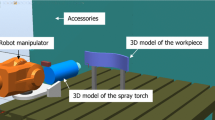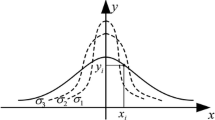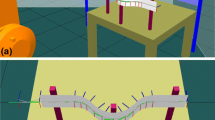Abstract
For high process reproducibility and optimized coating quality in thermal spray applications on complex geometries, atmospheric plasma spraying and high-velocity oxygen fuel torches are guided by advanced robot systems. The trajectory of the torch, the spray angle, and the relative speed between torch and component are crucial factors which affect the coating microstructure, properties, and, especially, the residual stress distribution. Thus, the requirement of high-performance thermally sprayed coatings with narrow dimensional tolerances leads to challenges in the field of robot-assisted handling, and software tools for efficient trajectory generation and robot programming are demanded. By appropriate data exchange, the automatically generated torch trajectory and speed profile can be integrated in finite element method models to analyze their influence on the heat and mass transfer during deposition. Coating experiments assisted by online diagnostics were performed to validate the developed software tools.










Similar content being viewed by others
References
C. Li, A. Killinger, and R. Gadow, Product Development with Thermally Sprayed Functional Coatings on Glass and Glass-Ceramics Substrates, H.T. Lin, Ed., Int. J. Appl. Ceram. Technol., 2005, 2(6), p 493-503
M. Buchmann, R. Gadow, D. Scherer, and M. Speicher, Ceramic Lightmetal Composites, Product Development and Industrial Application, Ceram. Eng. Sci. Proc. 23(4), p 103–113 (2002)
H. Kreye, F., Gärtner, A. Kirsten, and R. Schwetzke, High Velocity Oxy-Fuel Flame Spraying. State of the Art, Prospects and Alternatives, 5th HVOF Colloquium High Velocity Oxy-Fuel Flame Spraying (Erding, Germany) GTS Gemeinschaft Thermisches Spritzen e.V., Ed., Unterschleißheim, Germany, 2000, p 5-18
J. Ilavsky, A. Allen, G. Long, and S. Krueger, Influence of Spray Angle on the Pore and Crack Microstructure of Plasma-Sprayed Deposits, J. Am. Ceram. Soc., 80(3), p 733–742 (1997)
C.C. Berndt and S.H. Leigh, Evaluation of Off-Angle Thermal Spray, Surf. Coat. Technol., 89, p 213–224 (1997)
R. Gadow, M. Wenzelburger, Methods and application of residual stress analysis in thermally sprayed coatings and composites, Surf. Coat. Technol., 2006, 201(5), p. 1995–2001
A. Candel, R. Gadow, and D. López, Advanced robot assisted manufacturing and control system for the internal HVOF series coating process of cylinder bores in light weight engine manufacturing, SAE 2004 Trans. J. Mater. Manuf., 113(5), p 232–237 (2005)
H. Steffens, B. Wielage, and J. Drozak, Adhesion of thermally sprayed coatings; Adhesion in composite materials, DGM Informationsgesellschaft, Germany, 1989, p 115-128 (in German)
J. Wilson, J. Kim, J. Shadley, E. Rybicky, W. Emery, D. Somerville, J. Nuse, R. McGrann, and D. Greving, Fatigue Life of HVOF Tungsten Carbide Coated Aluminum and Hard Anodized Aluminum in Cyclic Bending and the Influence of Coating Residual Stresses, United Thermal Spray Conference (Düsseldorf, Germany), 1999, p 468-473
S. Ahmaniemi, P. Vuoristo, T. Mäntylä, J. Latokartano, and I. Salonen, Optimization of the Robot Controlled Plasma Spraying of Thermal Barrier Coating for Gas Turbine Transition Duct, Thermal Spray 2002, E. Lugscheider and C.C. Berndt, Ed., March 4-6, 2002 (Essen, Germany), DVS Deutscher Verband für Schweißen, Düsseldorf, Germany, 2002, p 208-212
S. Deng, H. Li, H. Liao, C. Coddet, C. Zeng, P. Charles, and P. Uriot, New Functions of Thermal Spray Toolkit. A Software Developed for Off-Line and Rapid Robot Programming, Thermal Spray 2006, B.R. Marple, M.M. Hyland, Y.C. Lau, C.J. Li, R.S. Lima, and J. Voyer, Ed., May 15-18, 2006 (Seattle, WA), ASM International, Materials Park, OH, 2006
R. Zieris and A. Schmidt, Off-Line Programming for Spraying and Laser Cladding of Three-Dimensional Surfaces, Thermal Spray 2004: Advances in Technology and Application, May 10-12, 2004 (Osaka, Japan), ASM International, Materials Park, OH, 2004
F. Trifa, G. Montavon, and C. Coddet, Integrating a Deposition Model for Off-line Spray Tools Programming, Thermal Spray 2005, E. Lugscheider, Ed., ASM International, Materials Park, OH, p 280-285, 2005
The Mathworks™, Matlab 2007 Function List; Version R2007a, 2007
Y. Bao, T. Zhang, and D.T. Gawne, Computational Model for the Prediction of the Temperature in the Coating during Thermal Spraying, Thermal Spray 2004: Advances in Technology and Application, May 10-12, 2004 (Osaka, Japan), ASM International, Materials Park, OH (2004)
E.S. Davids, S.R. Duncan, and P.S. Grant, Modelling and Validation of Substrate Heat Transfer Coefficient Distribution in Vacuum Plasma Spraying, Thermal Spray 2006, B.R. Marple, M.M. Hyland, Y.C. Lau, C.J. Li, R.S. Lima, and J. Voyer, Ed., May 15-18, 2006 (Seattle, WA), ASM International, Materials Park, OH, 2006
E. Dongmo, R. Gadow, and M. Wenzelburger (2008) Analysis and Optimization of the HVOF Process by Combined Experimental and Numerical Approaches. Surf. Coat. Technol., 202:4470-4478
A. Candel, R. Gadow, and M. Wenzelburger, Process Automatization for the Coating of Light Metal Engine Crankcases and Cylinder Liners—Modeling of Heat and Mass Transfer During Thermal Spraying on Complex Geometries, 8th CIRP International Workshop on Modeling of Machining Operations, R. Neugebauer, Ed., Verlag Wissenschaftliche Skripten, Zwickau, Germany, 2005, p 147-156
Acknowledgments
The authors would like to thank Dr. José Andrés Moreno and Mr. Alejandro Frutos (Universidad Politécnica de Cartagena, Spain) for their important contribution to the development of tools for the simulation by FEM of the temperature distribution on free form surfaces.
Author information
Authors and Affiliations
Corresponding author
Rights and permissions
About this article
Cite this article
Candel, A., Gadow, R. Trajectory Generation and Coupled Numerical Simulation for Thermal Spraying Applications on Complex Geometries. J Therm Spray Tech 18, 981–987 (2009). https://doi.org/10.1007/s11666-009-9338-x
Received:
Revised:
Accepted:
Published:
Issue Date:
DOI: https://doi.org/10.1007/s11666-009-9338-x




